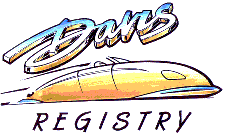
By 1946 hostilities in Europe and Japan were behind America. Many were looking ahead to the endless possibilities for the future. This same year Gary Davis started Davis Motor Car Company in Van Nuys, California.
Having sold cars since coming to Southern California in 1938, Davis saw a one-off roadster in 1945 built by the legendary Frank Kurtis for millionaire playboy Joel Thorne. Kurtis would go on to create his Kurtis-Kraft roadsters which dominated Indianapolis 500 races throughout the 1950s. Thorne started Thorne Engineering in Burbank for the purpose of building race cars for his Indy 500 attempts with the likes of craftsmen such as Kurtis.
Kurtis built the personal roadster for Thorne in 1938, which, among other unique features, incorporated a three wheel configuration—one in front and two in back. Thorne used the car regularly in the Los Angeles area, and that is where Davis first saw the unique roadster. Stories vary as to how Davis became owner of the three-wheeler dubbed “Californian”, but by 1945 new owner Davis started promoting the Californian as the prototype for a new automobile venture. With limited backing he assembled a small group of young engineers with nothing but the promise of twice normal salary once the company got on its feet. Continued use of the Californian heightened its rapid deterioration, prompting Davis to begin development of a new concept loosely based on the principals of the original Kurtis creation.
At this same time a 57,000 sq. ft. former aircraft assembly building in Van Nuys, California was acquired to house engineers and a future assembly line for the new Davis Motor Car Company, which increased interest, investors and franchise agreements.
A new prototype named “Baby” was soon created. Still three-wheeled and powered by a 47 hp Hercules 4-cylinder engine, with Borg-Warner 3-speed transmission and Spicer rear end, and with four- across seating, it was the basis for claims of production beginning in 1948 with a minimum of 50 cars a day, ramping up to 1000 soon after. Magazines, newspapers, investors and prospective dealers were all anxious for the new Davis “Divan” Sedan.
 A second prototype called “Delta” was built after Baby, with a third prototype known as the model 482 locking in production specifications and becoming the basis for the remainder of Davis sedans produced, which has been estimated to be 17. Production figures have been impossible to verify which was a reason for creation of the Davis Registry—to try and determine accurate production based on first hand interviews, documentation, and the 12 cars and 3 military vehicles extant.
A second prototype called “Delta” was built after Baby, with a third prototype known as the model 482 locking in production specifications and becoming the basis for the remainder of Davis sedans produced, which has been estimated to be 17. Production figures have been impossible to verify which was a reason for creation of the Davis Registry—to try and determine accurate production based on first hand interviews, documentation, and the 12 cars and 3 military vehicles extant.
As cars were slowly completed for testing and promotion, workers and engineers were not being paid, and lawsuits were threatened by investors and dealers. It was estimated that $1,200,000 was raised by Gary Davis with over 300 franchises in place waiting for the first shipment of Davis cars.
In May, 1948, 17 ex-employees filed suit for back wages, and Davis was being investigated by the Los Angeles District Attorney’s office for fraud. Soon after the Davis plant was shut down. By November the District Attorney raided Davis Motor Cars and seized all company records to help develop a case.
Just before the plant was closed Gary Davis, working with a skeleton crew, developed a variation of the 482 design for military use. Model 494 was a Jeep-like version of the Divan with an open body. Arrangements were ongoing with the Pentagon to run tests at the Aberdeen Proving Grounds in Maryland. Ultimately three 494’s were built in less than a week—two of which were shipped to the Army for testing.
By May, 1950, all assets of the Davis Motor Car Company were sold for tax claims. But the Davis was not dead, yet. 16 franchise holders, owning car #5 and some tooling, formed Delta Motor Car Company in an effort to salvage the Davis.
In 1953 an attempt was made by Delta to have Reliant Engineering Company in Staffordshire, England, manufacture the car. Though some reengineering took place and some tooling was created, investor funds had run out and the enterprise folded. Car #5 was scrapped for non-payment of duties by English customs officials.
Gary Davis was brought to trial on 28 counts of Grand Theft, ultimately being found guilty on 20 counts of fraud with 4 counts of not guilty and 4 being dropped. Though franchisees signed contracts stating no guarantees, the court found that purchases were based more on Gary Davis’ integrity and word, regardless of the contract wording.
The conviction was appealed, but on July 18, 1953 it was denied, and Davis was sent to a low security prison facility at Castaic, just north of Los Angeles, for two years.
Released in 1954, Davis went on to help develop Dodge-em bumper cars and the Start-O-Car amusement ride in the late-1950s. By the late-1960s he retired to Palm Springs, California, opening a small consulting firm called Engineering Associates, looking for investors to build a three-wheeled safety car called the Interceptor, which incorporated a 360-degree rubber bumper. He died from emphysema in 1973.
Many called it fraud, but still more hang the demise of the Davis on those classic hurdles to car development and production: inexperience, over ambition and under financing.





